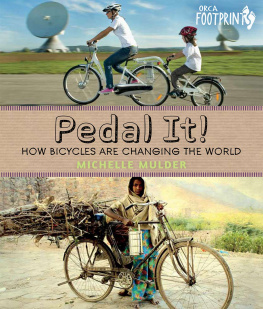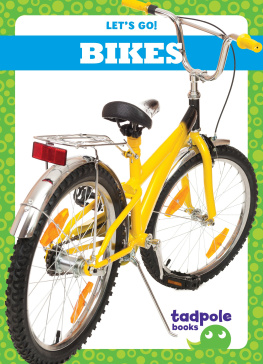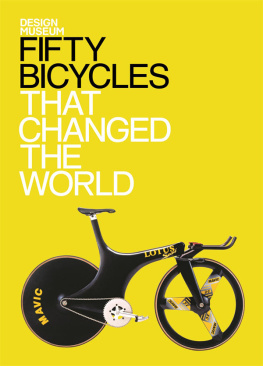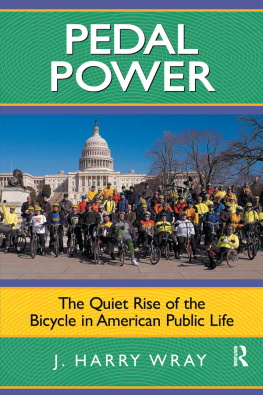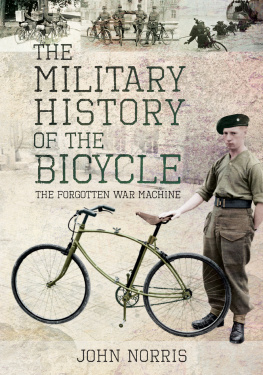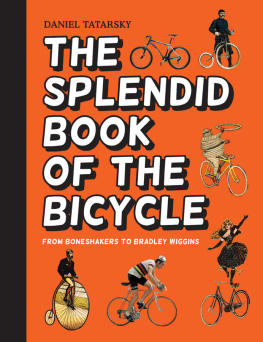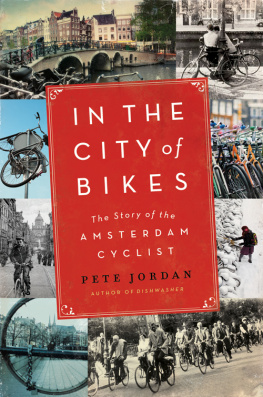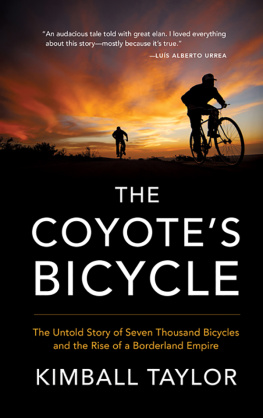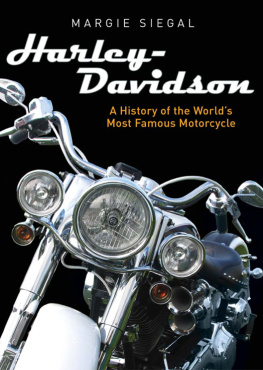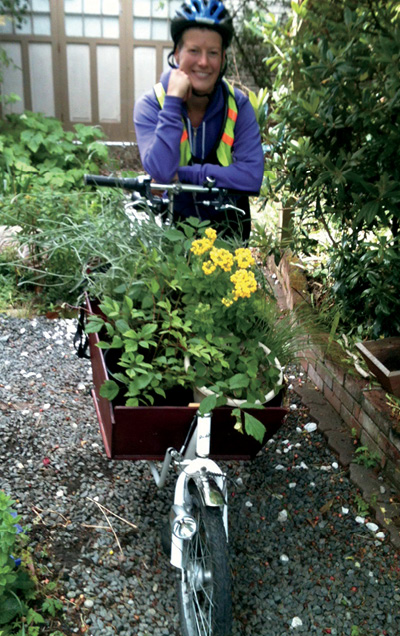
Me, my box-bike and a lovely load of flowers. Box-bikes are one of many kinds of cargo bikes. Cargo bikes are built to transport both people and a surprising variety of loads! GASTN CASTAO
What do you like most about riding a bicycle? Is it the freedom of flying down the road with the breeze tickling your skin? Do you notice sights and sounds you might miss if you were in a car? Do you thrill at going far and fast on your very own power?
I love cycling for all these reasons. In fact, I love it so much that Ive never owned a car. I pedal to the grocery store, to visit friends, to the library and even to local schools to talk to students about my books. When my daughter was eleven months old, I put a childs seat on my bicycle, and when she got too big for that, I got a special kind of bike called a box-bike. It has a wooden box in front big enough to hold her, her best friend and a few bags of groceries.
I love cycling, and I love traveling too. Wherever I go, I notice bicycles. Sometimes theyre common. Sometimes theyre not, and sometimes people use them in very surprising ways. Once, in Argentina, I watched a man power a knife sharpener by pedaling a bicycle, and I began thinking about just how much a bicycle can do. This book will take you on a ride around the world, where youll see bicycles being used in some astounding ways. Grab your helmet, hang on, and have fun!

In Buenos Aires, Argentina, knife sharpeners sound a special whistle as they pedal around a neighborhood. MICHELLE MULDER
On My Route
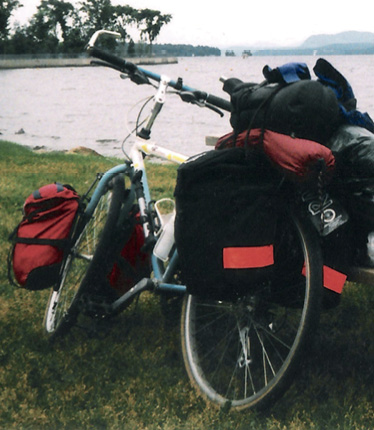
The first bike I bought, resting here at Lake Magog, Quebec. MICHELLE MULDER
I was fifteen when I bought my first bicycle, and I rode it for almost twenty years. One summer, I pedaled it more than six thousand kilometers (thirty-seven hundred miles) on a trip across Canada. Eventually, it looked so old that friends suggested I buy a new one. I refused until the gear system broke beyond repair. Finally, I donated the bike to Recyclistas, an organization in Victoria, British Columbia, Canada that gives new life to old bicycle parts. I like to imagine pieces of my old bicycle riding around Victoria and maybe even retracing my steps across the country.
CHAPTER ONE
Who Thought This Up, Anyway?
THE WALKING MACHINE
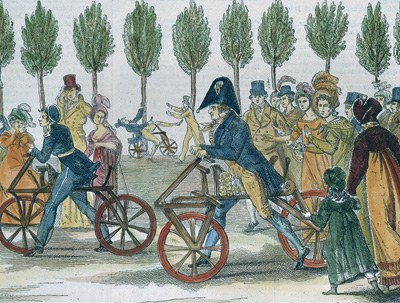
An engraving of a Draisienne from the early 1800s. Photos from those times are hard to come by because the camera was only just being invented. BRIDGEMAN ART LIBRARY
Whats the most important part of a bicycle: the tires, the chain, the pedals or maybe the brakes? Would you believe that early ancestors of the bicycle had none of those parts?
Picture a time before airplanes and cars, a time when people walked everywhere unless they had horses to ride. In 1817, the German nobleman Baron von Drais got tired of walking and invented a walking machine to help him get across his gardens faster: two in-line wooden wheels, connected to a wooden frame, with a handle connected to the front wheel for steering. The rider of the Draisienne would swing a leg over the frame, push back with alternate feet and roll forward. Riders could go up to eight or nine miles per hour. Walking pace is about three miles per hour. This increase in speed was exciting to many Europeans, and the Draisienne became a popular fad among those who could afford one.
THE BONESHAKER
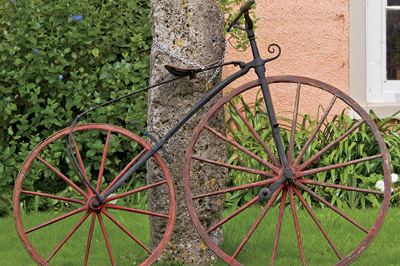
Cycling wasnt always the smooth, gliding experience we enjoy today. Imagine going down a bumpy road on this 19th-century bike.They didnt call them boneshakers for nothing! PJHPIX/DREAMSTIME.COM
Unfortunately for Baron von Drais, all roads in those days were dirt, gravel or cobblestone, and his new invention didnt work very well on bumpy surfaces. Eventually, people lost interest in the walking machine.
Within a few years, inventors began to experiment with pedals that would turn the wheels. Early versions of pedals were more like levers. In fact, the earliest pedaling systems were actually hand levers that riders used to add speed while running. No one liked the idea of taking their feet off the ground to ride.

How many differences can you spot between this bicycle and a modern one? HANSENN/DREAMSTIME.COM
It wasnt until the 1860s that inventors created a popular pedal. Some people credit French carriage maker Ernest Michaux for the invention, and other people say it was Pierre Lallement, who worked for him. The pedals and cranks were attached to the axle of the front wheel, and the rider could slow down or stop by pedaling backward.
Everyone wanted to try it. Businesspeople saw an opportunity, and bicycle manufacturing took off. Many large cities built schools to teach people to ride the velocipede, which means fast foot. Riders needed to have good coordination, be very strong and be willing to bounce around a lot. Velocipedes could weigh as much as 68 kilograms (150 pounds)the weight of an adult!and riding them was exhausting. Riding on bumpy surfaces was so uncomfortable that these bicycles were often called boneshakers.
On My Route

My daughter and friends gather at a local park for a push-bike rodeo. MICHELLE MULDER
Almost two hundred years after the Draisienne was invented, push bikes are becoming popular again, but this time its toddlers who are using them. Bicycles without pedals help small children learn to balance and go fast, even before they have the coordination needed for pedaling. We bought our daughter a push bike when she was two, and now her favorite pastime is soaring along the sidewalk with me running after her!
THE HIGH-WHEELER
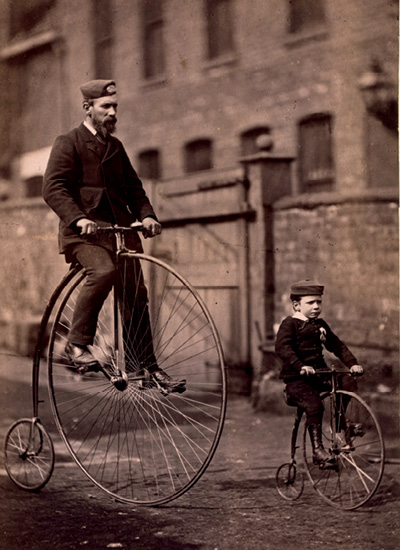
In 1879, this boy was photographed with his father, E.W. Shipton, who was a member of the Bicycle Touring Club in England. LORNE SHIELDS COLLECTION
In 1871, British engineer James Starley began selling the Ariel, or high-wheeler, a bicycle that was less painful to ride. Made of metal and with solid rubber tires, these bicycles had a huge front wheel, which helped them go farther with each turn of the pedal. Ariels were much more comfortable and efficient to ride than boneshakers, but much harder to get onto. Heres what you had to do.
- Stand behind the bicycle.
- Put your left foot onto the step just above the little wheel.
- Use your right leg to push off along the ground, causing the bicycle to roll.
- When you get enough momentum, straighten your left leg, jump forward into the saddle and start pedaling. Oh, and watch out if you are going down a hill, because the pedals go faster and faster as the front wheel spins faster!

